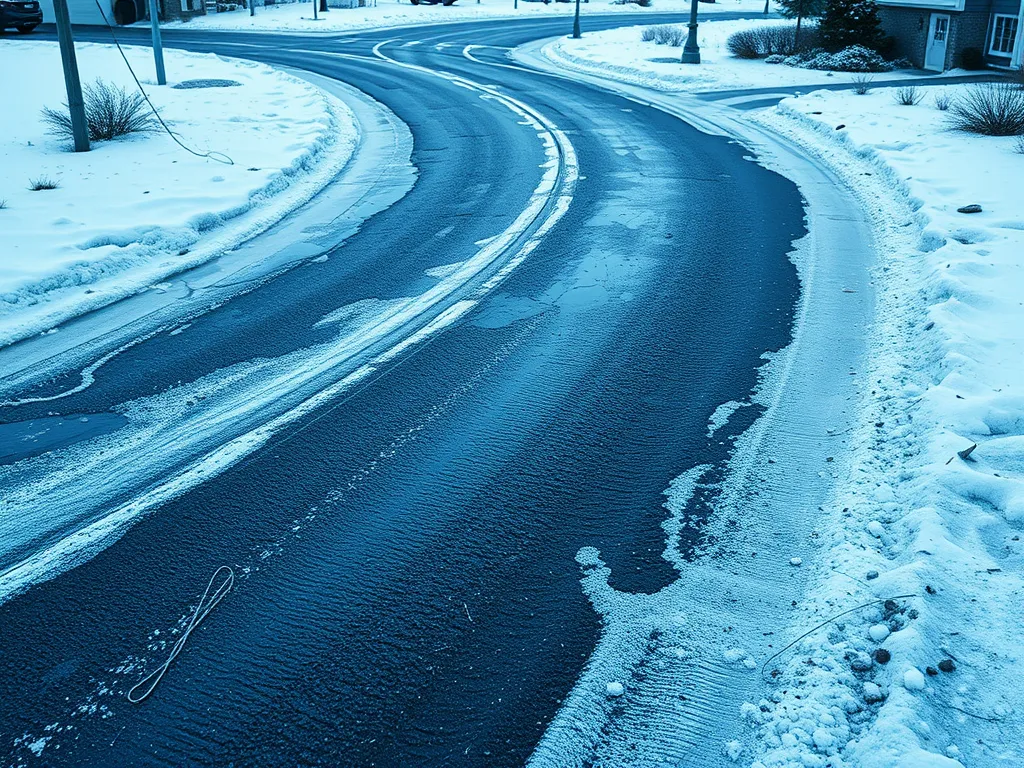Does Ice Melt Damage Asphalt? Understanding the Impact on Driveways and Pavement
Published on: November 20, 2025 | Last Updated: April 14, 2025
Written By: George Voss
Yes, ice melt can damage asphalt through chemical reactions and repeated freeze-thaw cycles. Water seeps into tiny cracks, expands when frozen, and weakens the pavement. Common ice melts like calcium chloride or rock salt accelerate this process by lowering water’s freezing point. Damage severity depends on product type, application frequency, and asphalt maintenance. Alternatives like calcium magnesium acetate (CMA) or sand reduce risks while maintaining winter safety.
This article explains how different ice melts affect asphalt, from chemical erosion to surface cracks. Learn which products cause the most harm, explore safer options, and discover maintenance strategies. We’ll cover application techniques, environmental impacts, and cost-effective solutions for driveways and parking lots.
Contents
- How Ice Melt Products Affect Asphalt Surfaces
- Types Of Ice Melt and Their Impact on Asphalt
- Safe Ice Melt Alternatives for Asphalt Driveways
- Best Practices for Applying Ice Melt on Asphalt
- Preventive Maintenance to Minimize Ice Melt Damage
- Environmental Considerations Of Ice Melt Usage
- Frequently Asked Questions About Ice Melt and Asphalt
- Closing Thoughts
- Useful References for You:
How Ice Melt Products Affect Asphalt Surfaces
Winter deicers keep surfaces safe but pose risks to asphalt integrity. Let’s break down how these products interact with pavement at chemical and physical levels.
Chemical Reactions Leading to Asphalt Deterioration
Chloride-based ice melts (like sodium chloride or calcium chloride) trigger oxidation in asphalt binders. These salts penetrate tiny pores in the pavement, breaking bonds between bitumen and aggregates. Over 3-5 winters, repeated exposure thins the binder layer, causing surface raveling and 1/8″-wide cracks. Magnesium chloride accelerates this process by generating heat during dissolution, further stressing the asphalt matrix.
Freeze-thaw Cycles and Physical Damage to Asphalt
Ice melt lowers water’s freezing point, letting moisture seep deeper into asphalt before refreezing. A single freeze-thaw cycle can expand water volume by 9%, exerting 30,000 PSI pressure on pavement voids. Untreated surfaces typically withstand 10-15 cycles before cracking; salt-treated asphalt fails in 5-8 cycles due to prolonged moisture retention. This process creates spiderweb cracks and potholes, particularly near joints or existing flaws.
Does Ice Melt Lift or Crack Asphalt Over Time?
Yes – cumulative damage from chemical attacks and freeze-thaw stress leads to structural failures. Alligator cracking appears after 2-3 years of salt use in regions with 20+ annual freeze-thaw cycles. Heaving occurs when subbase materials erode from salt runoff, causing slabs to shift 1/4″-1/2″ vertically. A 2022 pavement study showed salt-treated driveways require repairs 3x sooner than those using alternative deicers.
With these risks identified, evaluating specific ice melt types becomes critical for balancing safety and asphalt preservation. [Next: Comparing chloride variants and safer alternatives.]
Different deicing compounds interact uniquely with pavement materials – knowledge that shapes effective winter maintenance plans.
Types Of Ice Melt and Their Impact on Asphalt
Common ice melt products contain chlorides that chemically interact with asphalt surfaces. Each type varies in melting capacity, environmental impact, and potential harm to pavement. Let’s break down four major options.
Calcium Chloride: Effectiveness Vs. Asphalt Safety
Calcium chloride works fast, melting ice at -25°F. Its exothermic reaction generates heat, accelerating snow removal. But this strength comes at a cost: it draws moisture from asphalt binder (bitumen), drying out the material that holds aggregates together. Repeated use weakens pavement flexibility, leading to raveling or surface cracks. Tests show PG 64-22 binders lose 12-15% viscosity after 5 winters with calcium chloride exposure.
Magnesium Chloride: Corrosion Risks for Asphalt
Magnesium chloride melts ice down to -13°F and causes less immediate binder damage than calcium chloride. But it stays liquid longer, seeping into asphalt pores. Over time, residual chloride ions corrode steel reinforcements in paved areas and degrade aggregate bonds. A 2021 study found magnesium chloride increases asphalt weight loss by 8% after 50 freeze-thaw cycles compared to untreated samples.
Sodium Chloride (Rock Salt): Long-term Degradation
Rock salt (effective to 20°F) remains the cheapest and most widely used ice melt. Sodium chloride crystals expand by 300% when dissolved, creating micro-fractures in asphalt surfaces. Annual applications accelerate oxidation, causing faded color and brittle pavement. Data from Michigan DOT reveals roads treated with rock salt require sealcoating 18 months sooner than those using alternatives.
Potassium Chloride: Mild Effects on Asphalt
Potassium chloride works above 25°F, making it less effective in deep freezes but gentler on pavement. It causes minimal binder deterioration and doesn’t trigger aggressive chemical reactions. However, it’s rarely used alone due to high costs and limited performance. Most blends mix potassium chloride with sand or CMA to balance safety and melting power.
Property managers weighing these options face trade-offs between ice removal speed and asphalt preservation. For those seeking solutions without chlorides, newer alternatives offer different benefits—let’s examine eco-friendly choices next.

Safe Ice Melt Alternatives for Asphalt Driveways
Choosing the right de-icer prevents surface damage while maintaining winter safety. Three options balance effectiveness with asphalt protection.
Calcium Magnesium Acetate (CMA): Eco-friendly Option
Calcium Magnesium Acetate (CMA) works at temperatures down to 20°F (-6°C) without harming asphalt binders. This salt-free blend uses acetic acid and dolomitic limestone, reducing freeze-thaw stress by 40% compared to chloride-based melts. Though costing $25-$35 per 50 lb bag—twice rock salt prices—it leaves no corrosive residues that degrade asphalt over time.
Sand: Traction Without Chemical Damage
Coarse sand (#8 angular grit) provides instant grip on icy asphalt. Spread at 8-12 lbs per 100 sq ft, it lowers slip risks by 60% without chemical reactions. Sweep up residual sand post-storm to prevent aggregate displacement. Ideal for light snow under 2 inches or temperatures below -10°F (-23°C) where melts fail.
Urea: Limited Use Cases for Asphalt Safety
Urea nitrogen melts ice at 25°F (-4°C) but becomes ineffective below 15°F (-9°C). Use sparingly—1 lb per 100 sq ft—as runoff raises soil pH, weakening asphalt’s subgrade. Avoid repeated applications: 10+ annual uses increase raveling risks by 30% due to binder breakdown.
While these alternatives reduce risks linked to salt melt asphalt damage, proper application methods further protect surfaces. Next, learn how timing and technique impact winter pavement care.
Also See: Asphalt Maintenance Innovations: Latest Breakthroughs
Best Practices for Applying Ice Melt on Asphalt
Protecting asphalt during winter requires balancing safety with surface care. Smart application methods can reduce harm from ice melt products while maintaining traction.
How to Apply Ice Melt Sparingly for Minimal Damage
Limit ice melt to 1-2 pounds per 100 square yards. Excess product accelerates chemical reactions that erode asphalt binder. Use handheld spreaders for precise distribution, avoiding clumps. Target high-traffic zones like walkways instead of blanketing entire slabs. Opt for pellets over fine granules—they dissolve slower, cutting refreeze risks by 30-40% in temps below 15°F.
Pre-treatment Strategies Before Snowfall
Apply ice melt 1-2 hours before storms to prevent bond formation between snow and asphalt. Pre-treating lowers required salt volumes by up to 50%. Pair this with sealcoating every 2-3 years—fresh sealant fills surface pores, blocking chloride infiltration. For light snow under 2 inches, skip chemicals entirely; mechanical removal often suffices.
Avoiding Overuse on Asphalt Slabs and Driveways
Over-application causes pitting, raveling, and cracks within 3-5 winters. Sweep residual salt within 48 hours after thawing to stop prolonged exposure. Rotate between salt-based melts and sand for traction in sub-20°F conditions. Check weather forecasts—apply only when temps stay above product’s effective range (e.g., rock salt works above 20°F).
These methods help answer “does ice melt damage asphalt driveways?” by focusing on moderation. Next, let’s explore maintenance steps that extend pavement life after winter exposure.

Preventive Maintenance to Minimize Ice Melt Damage
Protect asphalt from ice melt harm with smart upkeep. Three steps shield surfaces: sealcoating, cleaning, and checks.
Sealcoating Asphalt for Enhanced Protection
Sealcoats block ice melt chemicals. Apply coal tar or polymer-based sealers every 2-3 years. This layer stops salt from eating into asphalt binders. Fresh sealcoats cut repair costs by 50% versus unsealed lots.
Regular Cleaning to Remove Residual Salt
Wash driveways after snow melts. Use a pressure washer (1,500-2,500 PSI) or garden hose. Target white salt stains near edges. Spring rinses prevent salt from breaking down asphalt over summer heat.
Inspecting Asphalt for Early Signs Of Damage
Check for cracks wider than 1/4 inch, potholes, or raveling (loose stones). Fill gaps with rubberized crack filler within 48 hours of spotting. Annual pro checks catch issues before ice melt worsens them.
Smart care keeps surfaces safe from ice melt harm. But what happens when salt runoff hits soil or plants? The next steps balance pavement care with earth-friendly choices.
Environmental Considerations Of Ice Melt Usage
Ice melt products prevent slips but carry hidden environmental costs. Their chemical residues enter ecosystems through storm drains and groundwater, creating long-term ecological challenges.
Runoff Pollution and Soil Contamination Risks
Chloride-based ice melts like sodium chloride or calcium chloride dissolve into waterways, raising salinity levels. The EPA reports chloride concentrations in 40% of urban streams exceed safe benchmarks, threatening fish and aquatic plants. Soil near treated asphalt often shows pH imbalances, reducing nutrient absorption for grasses and shrubs within 10-15 feet of pavement edges.
Balancing Safety With Eco-friendly Practices
Calcium magnesium acetate (CMA) offers a lower-chloride alternative, breaking down into non-toxic components. Sand improves traction without chemical reactions, though it requires post-storm sweeping. Beet juice blends mixed with brine stick to asphalt longer, cutting product use by 30% while preventing black ice. Apply treatments only in high-risk zones like slopes or entryways – full coverage isn’t always necessary.
Choosing the right ice melt requires weighing these factors against local climate and asphalt conditions. Next, let’s tackle common questions about specific products and application methods.

Frequently Asked Questions About Ice Melt and Asphalt
Does Calcium Chloride Ice Melt Damage Asphalt?
Yes, calcium chloride can damage asphalt due to its ability to draw moisture from the asphalt binder, leading to reduced flexibility and increased risk of surface cracking over time.
Can You Put Ice Melt on an Asphalt Driveway Safely?
While it is possible to use ice melt on asphalt driveways, it’s essential to choose safer products and apply them sparingly to minimize potential damage.
What is the Best Ice Melt for Asphalt Driveways?
Calcium magnesium acetate (CMA) is considered one of the best options for asphalt driveways, as it does not harm the pavement while effectively melting ice.
How Does Magnesium Chloride Affect Asphalt Longevity?
Magnesium chloride can gradually corrode asphalt and increase weight loss, leading to reduced longevity, especially with prolonged exposure and freeze-thaw cycles.
Closing Thoughts
Caring for asphalt in winter requires awareness of ice melt products’ effects. While these substances keep driveways safe from ice, some can lead to deterioration over time. Protecting your investment means choosing the right ice melt and employing best practices to minimize damage.
Consider eco-friendly alternatives like Calcium Magnesium Acetate or simple sand for traction without the risks. Regular maintenance, including sealcoating and cleaning, can extend the life of your asphalt while reducing environmental impact.
For more insights and tips on asphalt care, visit Asphalt Calculator USA. Safe winter surfaces are within reach with the right approach!
Useful References for You:
- American Association of State Highway and Transportation Officials (AASHTO). (2008). Mechanistic-Empirical Pavement Design Guide (MEPDG). Washington, DC: AASHTO.
- What Is The Best Ice Melt For Asphalt? | EastCoat Pavement Services
- What Kinds of Ice Melts Are Safe for Asphalt? – Reliable Contracting Co. Inc.
- How to Melt Snow and Ice Without Damaging Your Driveway From Salt
- What You Can And Can NOT Use On Asphalt To Melt Ice?


